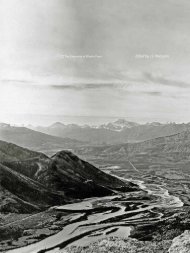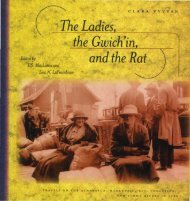Paul Kane's Journal of his Western Travels, 1846-1848 - History and ...
Paul Kane's Journal of his Western Travels, 1846-1848 - History and ...
Paul Kane's Journal of his Western Travels, 1846-1848 - History and ...
Create successful ePaper yourself
Turn your PDF publications into a flip-book with our unique Google optimized e-Paper software.
<strong>Paul</strong> Kane. NORWAY HOUSE. July or August. <strong>1846</strong>. Oil on paper. 8x /3". Collection. Stark Museum <strong>of</strong> Art.<br />
Nepersey T<strong>his</strong> is <strong>Kane's</strong> spelling <strong>of</strong> the French words Nez<br />
Perces which were used to identify the tribe Nez Perces. Given<br />
that Kane rode from Fort Walla Walla, on the Walla Walla<br />
River, overl<strong>and</strong> to the Tuchci/Tushciy (Touchet) River <strong>and</strong> on<br />
again thirty miles to the Nepersey, which he had to cross to see<br />
the Palouse River valley <strong>and</strong> to recross to go to the Whitmans'<br />
mission, <strong>and</strong> given that WA describes the "Nezperees" River<br />
as being "250 yards wide ... at the mouth <strong>of</strong> Palouse River"<br />
(191), the journal's Nepersey is a misnomer for the Snake<br />
(once the Lewis) River, the foremost tributary <strong>of</strong> the Columbia<br />
River. It joins the Columbia at modem Pasco, Washington, at<br />
the lower great bend, where the Columbia makes its final<br />
dramatic change <strong>of</strong> direction toward the Pacific Ocean.<br />
nesqualey /N~ualy /N~uuly/Nesqualy Fort Nisqually<br />
(est. 1833) was visited by Kane April 7 <strong>and</strong> June 15, 1847. In<br />
1841, Captain Charles Wilkes (see WiIk's party, Capt) described<br />
t<strong>his</strong> fort, located at the southeastern end <strong>of</strong> Puget<br />
Sound, near the site <strong>of</strong> modem Nisqually, Washington, as<br />
being "constructed <strong>of</strong> pickets, enclosing a space about two<br />
hundred feet square, with four comer bastions. Within t<strong>his</strong><br />
enclosure are the agents' stores, <strong>and</strong> about half a dozen houses,<br />
built <strong>of</strong> logs, <strong>and</strong> ro<strong>of</strong>ed with bark." By 1847, it had been<br />
transformed mainly into a fann, operated by the Puget Sound<br />
80<br />
Agricultural Company, a company formed by the HBC but<br />
distinct from it. By 1847, the farm had 6000 sheep <strong>and</strong> 2000<br />
cattle; it was successfully exporting wool to Russia, Hawaii,<br />
<strong>and</strong> Engl<strong>and</strong> (WA [142]).<br />
Nesqualy Chief In <strong>his</strong> l<strong>and</strong>scape <strong>and</strong> portrait log, Kane names<br />
t<strong>his</strong> chief Lach-o-let <strong>and</strong> calls the Nisqually "the largest<br />
Indians I have met with ... WA speUs <strong>his</strong> name "Lach-oh-Iett"<br />
(143).<br />
Norway House Norway House (est. 1814) was visited by Kane<br />
July II to August 13, <strong>1846</strong>, <strong>and</strong> July 18-23, <strong>1848</strong>. Originally<br />
on Lake Winnipeg, in 1826 t<strong>his</strong> post was moved to the site<br />
visited by Kane, on Playgreen Lake, at the northeastern outlet<br />
<strong>of</strong> Lake Winnipeg. Its name derives from the Norwegian<br />
axmen who were hired to open l<strong>and</strong> communications to York<br />
Factory <strong>and</strong> Hudson Bay. The post served as the divisional<br />
point for goods coming up from Hudson Bay <strong>and</strong> destined for<br />
inl<strong>and</strong> posts to the west, south, <strong>and</strong> north. As well, the company's<br />
famous York boats were built at t<strong>his</strong> point. Other<br />
distinctions include the fact that the Northern Council <strong>of</strong> the<br />
HBC met annually at t<strong>his</strong> post, as Kane observes on July 18,<br />
<strong>1848</strong>; Sir George Simpson had a residence there <strong>and</strong> presided<br />
at the meetings; the Reverend J. Evans invented Cree syUabic<br />
Guide
















